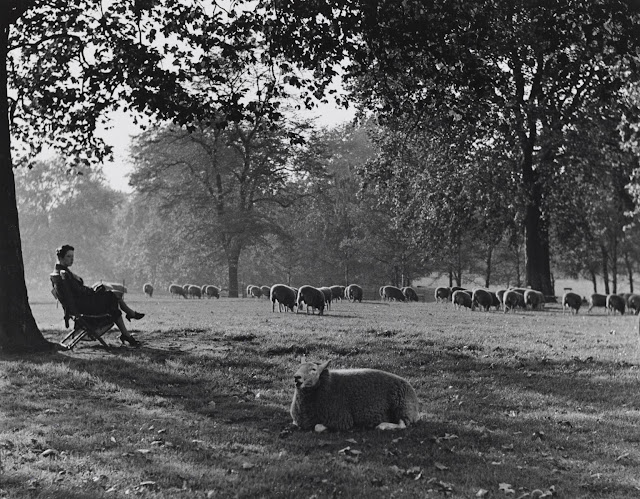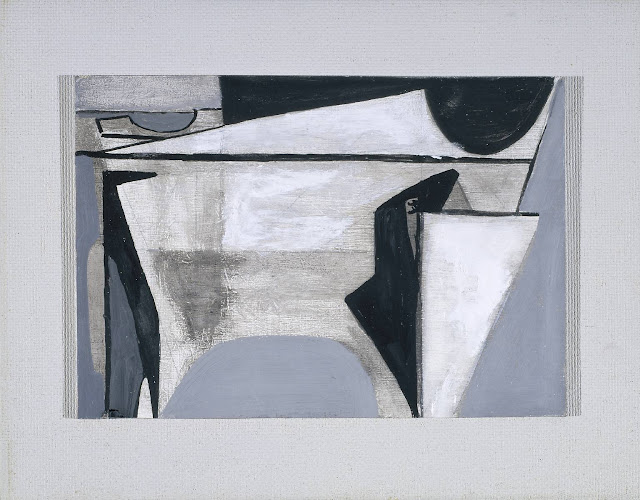 |
| William Coldstream Standing Nude 1937 oil on canvas Tate Gallery |
"In 1937 Coldstream founded the Euston Road School with fellow realist artists Claude Rogers and Victor Pasmore. Believing that avant-garde art had lost touch with all but a small elite, they aimed to record the visible world in an objective manner and re-establish a connection between artist and public. This work was painted in the School's first location at 12 Fitzroy Street in autumn 1937. Coldstream's practice was based on an idea of 'straight painting' in which disinterested vision and precise measurement would replace the personal and subjective, thus creating a direct transcription of what the painter saw."
 |
| Alexandre Jacovleff A Model seated on a Bed (recto) ca. 1937 tempera on paper Tate Gallery |
 |
| Alexandre Jacovleff A Model seated on a Bed (verso) Nude Figures in a Room ca. 1937 tempera on paper Tate Gallery |
"These two tempera sketches on verso and recto of a single sheet are from a series of experimental studies in a freer, more imaginative style which Jacovleff executed in the last two or three years of his life. His friend and biographer Martin Birnbaum records, 'Early in May 1938 while he was preparing to leave Paris, he told me that all these sheets of fleeting notes would soon be destroyed, and in his studio in Capri he would do the permanent work which he was impatient to begin and which he believed would be the solid lasting achievement of his career.' Shortly afterwards, however, he was stricken with cancer and died. This sheet was purchased from the artist's mother in 1939 and presented anonymously to the Tate."
 |
| Julian Trevelyan The Potteries ca. 1938 oil on canvas Tate Gallery |
"The painting dates from the years when Trevelyan was allied with the left-wing Mass Observation group. Founded in 1937 by anthropologist Tom Harrison and writer Charles Madge, Mass Observation was a study of the British working class. It was a purely information-gathering project, intended to accumulate data for future generations to analyse (presently housed in an archive at Sussex University). While the primary agents were hundreds of amateur diarists, photographers and painters also participated. Trevelyan traveled through The Potteries, a group of manufacturing towns in the region of Stoke-on-Trent, describing the area as 'a landscape full of drama and pathos,' where 'human beings seemed to creep about almost apologetically among the man-made disasters."
 |
| Man Ray Pisces 1938 oil on canvas Tate Gallery |
 |
| Jackson Pollock Naked Man with Knife ca. 1938-40 oil on canvas Tate Gallery |
"This picture, which was never exhibited or titled in Pollock's lifetime, has been given the title Naked Man with Knife by the compilers of the catalogue raisonné (O'Connor and Thaw) who assign it to the period ca. 1938-41. In his article in Artforum, O'Connor stresses the influence of José Clemente Orozco on Pollock's work at this period and suggests that this picture (as well as showing Orozco's stylistic influence) utilizes figure motifs borrowed from Orozco's frescoes at Dartmouth College in Hanover, New Hampshire, painted in 1932-34 (now lost)."
 |
| Charles Ginner Snow in Pimlico 1939 oil on canvas Tate Gallery |
"The view in this unusually small painting is from the second-floor window of 66 Claverton Street in Pimlico, where Ginner lived from 1938. He painted it during his first winter in the house. The woman in No. 73 opposite is brushing the snow from her steps and the pavement. The dark orange color of her pullover is repeated in the curtains in the ground-floor windows. The niches at the bases of the porch columns are boot scrapers. Ginner plays with the pigment as both a representation and a material: the white paint sits like the white snow on top of the red pillar box, as do the painted footprints that mark recesses in the snow on the pavement."
 |
| Charles Ginner Emergency Water-Storage Tank 1942 oil on canvas Tate Gallery |
"The London Fire Brigade constructed 'emergency water supplies' during the Second World War to supply water to their fire engines. There was a particular problem with water supply, both because the water mains were broken during bombing and because the river Thames is tidal and so at low tide it was difficult to pump water. At the beginning of the war 'portable dams' which held 1,000 gallons of water and were placed on open ground were ready to be moved into threatened areas of the city. These were supplemented later by larger steel structures that held up to 5,000 gallons, sited in the middle of streets and kept full with water changed every month or so. In the event, both these types of structures were of limited use as they were not large enough to provide water for more than a few minutes. London was bombed between September 1940 and May 1941. As buildings were destroyed, the water supply for the Fire Brigade was supplemented further by reservoirs built in the basements of bombed buildings and sealed in concrete. Although much larger than the tanks on the ground, these were also of only limited help. The water tank depicted was at the building which was formerly 222 Upper Thames Street, between Boss Court and St. Peter's Churchyard in London. The building had been the offices of a firm of twine makers, Morrison, James and Son Ltd. The scene looks oddly like a Roman bath, as Ginner included a little classical- style column at the right, which was presumably once part of the interior structure. The pre-war plan of this street is unrecognisable today."
 |
| Bernard Meninsky Standing Female Nude in a Landscape ca. 1940-43 oil on canvas Tate Gallery |
"Soon after the outbreak of war in 1939 the activities of the Central School of Arts and Crafts, where Bernard Meninsky had taught for many years, ceased in London. As a consequence Meninsky lost his job, and in 1940 he moved to Oxford where he taught at the City of Oxford Art School. While in Oxford he painted this picture, among a series of figures in landscapes, all from the imagination. Dr. Marjorie Franklin, who bequeathed the painting to the Tate Gallery, lived in Oxford during the war and met Meninsky in 1940, acquiring this work soon after it was painted."
 |
| John Piper Seaton Delaval 1941 oil on canvas, mounted on panel Tate Gallery |
"The baroque castle of Seaton Delaval, Northumberland, was built by John Vanbrugh between 1718 and 1729, and destroyed by fire in 1822. Piper visited the surviving ruin in 1941. He had previously made records of major buildings in anticipation of their destruction through bombing or modernisation. He had also recorded bomb-damage, and found parallels between the ruined castle and these recent subjects. Piper described the castle's colouring as 'ochre and flame licked red, pock-marked and stained."
 |
| Lawrence Gowing Mrs Roberts 1944 oil on canvas Tate Gallery |
"A student of the Euston Road School, Lawrence Gowing attended throughout its existence. This later portrait of Mrs. Ellen Roberts, the Gowings' cleaning lady, was painted at their home in Paultons Square, Chelsea. In 1945 the Daily Sketch reported the sitter's comments: 'It's me, isn't it? Perhaps in another hundred years I will be hanging in a national museum.' In 1983 Sir Lawrence described Mrs. Roberts as 'gaunt and gracious.' He also recalled how, when studying the work of Masaccio at that time, he 'realised that not only the transverse lighting but the unidealised sympathy and the visual authenticity that I prized in painting were all his invention."
 |
| Graham Sutherland Horned Forms 1944 oil on panel Tate Gallery |
"Despite the heavy commitment demanded by his status as an official war artist, Sutherland continued to make personal pictures derived from natural sources throughout the war. This threatening creature was based on a root which Sutherland found in Kent and which he took back to the studio. Through his characteristic 'paraphrasing' of its form it has metamorphosed into an image of ambient violence."
 |
| Graham Sutherland Feeding a Steel Furnace 1941-42 oil on canvas Tate Gallery |
"During the war the production of steel was especially urgent as Britain, cut off from foreign imports, sought to correct the arms shortage that, despite the process of rearmament that had begun in 1936, had left the nation vulnerable at the end of the 1930s. The arms crisis had been exacerbated by the abandonment of almost all of the British army's equipment on Dunkirk Beach in June 1940. Such was the demand that nationwide collections of scrap iron and steel were instigated; most famously, the cast-iron railings in many cities were removed to be turned into weapons. The inclusion of scrap metal alongside pig iron in the steel-making process was normal practice, and it is the introduction into the furnace of the 'scrapbox' at the end of a long delivery arm that is depicted in this work. The opening of the door of the furnace allowed in air, creating the tongue of yellow flame at the centre of the composition."
 |
| Roger Hilton Woman with Dark Hair 1949 lithograph Tate Gallery |
 |
| Giorgio Morandi Still Life 1946 oil on canvas Tate Gallery |
"Still Life was made in Bologna in 1946. The canvas was prepared with a white ground layer; an underdrawing made with graphite is visible around the central vase. The oil paint was then applied in thin layers, wet on wet, with lively brushstrokes. Morandi kept a supply of vases, bottles and jars in his studio, which he used as models for many of his still life paintings in a variety of arrangements. In his treatments they lose their domestic purpose, tending more toward sculptural objects of contemplation. However, his fondness for the earthy colours of his native Bologna helps to anchor such works in the artist's own life and surroundings."
– quoted passages based on notes by curators at the Tate in London









































